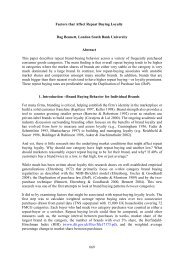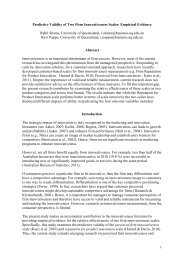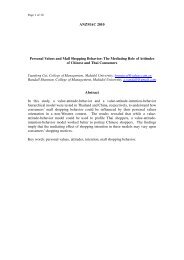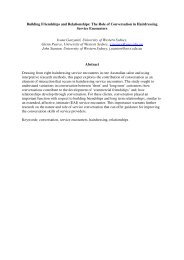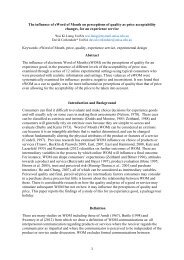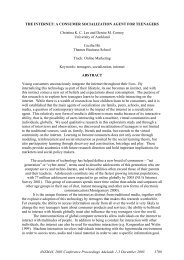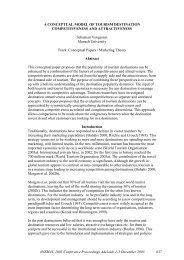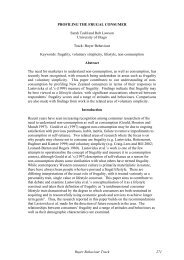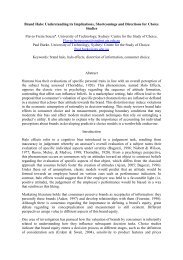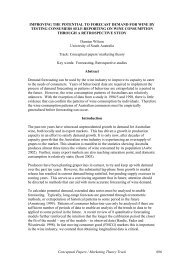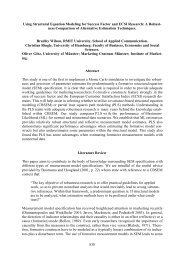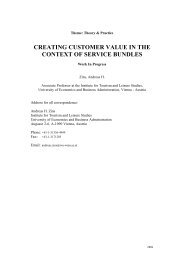amj Australasian Marketing Journal - ANZMAC
amj Australasian Marketing Journal - ANZMAC
amj Australasian Marketing Journal - ANZMAC
You also want an ePaper? Increase the reach of your titles
YUMPU automatically turns print PDFs into web optimized ePapers that Google loves.
Fashion Clothing Involvement<br />
10. Implications<br />
The implications of this study are firstly that the much touted<br />
significance of self-monitoring in effecting consumers<br />
involvement with product such as fashion clothing may need<br />
to be scrutinized more closely. At a practical level determining<br />
the extent that a target market contains high or low selfmonitors<br />
and then assuming involvement with ones visibly<br />
consumed product and constructing appeals based on the<br />
proposed character of the self-monitor could be misdirected<br />
and a wasted effort. However, the materialism-involvement<br />
link is much stronger and would indicate marketing mix<br />
strategies based on the characteristics of the materialist and<br />
their involvement levels are warranted. There is also a strong<br />
need to identify key motives that drive consumption of fashion<br />
clothing to be sure that marketing communications not<br />
only focuses on the nature of the materialist and self-monitor<br />
and appeal to their characteristics, but also include social<br />
versus sensory consumption motives.<br />
Further, assuming that high self-monitors are also highly<br />
materialistic may again need rethinking. Whilst the findings<br />
indicate that there is an effect on materialism by self-monitoring<br />
it was not a strong as the literature alluded to. The findings<br />
of this study require further exploration, particularly so<br />
with respect to examining or re-examining the findings of past<br />
studies. As such, much more work is warranted on self-monitoring<br />
in a marketing context. However, if the findings of this<br />
study hold and future studies using self-monitoring find only<br />
moderate associations with other consumer behaviour variables<br />
and constructs, one may exclaim self-monitoring why<br />
all the fuss .<br />
References<br />
Alwin, D., Hauser, R., 1975. Decomposition of Effects in Path<br />
Analysis. American Sociological Review, 40, 37-47.<br />
Auty, S., Elliott, R., 1998. Fashion involvement, self-monitoring<br />
and the meaning of brands. <strong>Journal</strong> of Product and<br />
Brand Management, 7 (2), 109-123.<br />
Arora, R., 1982. Validation of an S-O-R model for situational,<br />
enduring, and response components of involvement.<br />
<strong>Journal</strong> of <strong>Marketing</strong> Research, 19 (November), 505-516.<br />
Arora, R., 1985. Consumer involvement what it offers to<br />
advertising strategy. International <strong>Journal</strong> of Advertising,<br />
4,119-130.<br />
Beatty, S., Smith, S., 1987. External search effort: An investigation<br />
across several product categories. <strong>Journal</strong> of Consumer<br />
Research,14(June),83-95.<br />
Becherer, R., Richard, L., 1978. Self-monitoring as a moderating<br />
variable in consumer Behavior. <strong>Journal</strong> of Consumer<br />
Research, 5,159-162.<br />
Belk, R., 1984. Three scales to measure constructs related to<br />
materialism: Reliability, validity, and relationships to meas-<br />
58 <strong>Australasian</strong> <strong>Marketing</strong> <strong>Journal</strong> 9 (1), 2001<br />
ures of happiness. Advances in Consumer Research, 11,291-297.<br />
Belk, R., 1985. Materialism: trait aspects of living in a material<br />
world. <strong>Journal</strong> of Consumer Research,12(December),265-280.<br />
Bell, S., Holbrook, M and Solomon, M.1991. Combining esthetic<br />
and social value to explain preferences for product styles with<br />
the incorporation of personality and ensemble effects. <strong>Journal</strong> of<br />
Social Behavior and Personality, 6(6),243-274.<br />
Bloch, P., 1981. An exploration into the scaling of consumers<br />
involvement with a product Class. Advances in Consumer<br />
Research, 8, 61-65.<br />
Bloch, P., 1982. Involvement beyond the purchase process:<br />
Conceptual issues and empirical investigation. Advances in<br />
Consumer Research, 9,413-417.<br />
Bloch, P., 1986. Product Enthusiasm: Many Questions, A Few<br />
Answers. Advances in Consumer Research, 13,539-543.<br />
Bloch, P., Sherrell, D., Ridgeway, N., 1986. Consumer search:<br />
An extended framework <strong>Journal</strong> of Consumer Research,<br />
13(June),119-126.<br />
Bloch, P., Richins, M., 1983. A Theoretical model for the<br />
study of product importance perceptions. <strong>Journal</strong> of<br />
<strong>Marketing</strong>,47,69-81.<br />
Briggs, S., Cheek, J., .1986. The role of factor analysis in the<br />
development and evaluation of personality scales.<br />
<strong>Journal</strong> of Personality, 54(1),106-148.<br />
Briggs, S., Cheek, J., buss, A., 1980. An analysis of the selfmonitoring<br />
scale. <strong>Journal</strong> of Personality and Social<br />
Psychology, 38(4),679-686.<br />
Brody, R., Cunningham, S., 1968. Personality variables and<br />
the consumer decision Process. <strong>Journal</strong> of <strong>Marketing</strong><br />
Research, 5 (February),50-57.<br />
Browne, B., Kaldenberg, D., 1997. Conceptualizing selfmonitoring:<br />
links to materialism and product involvement.<br />
<strong>Journal</strong> of Consumer <strong>Marketing</strong>, 14(1),31-44.<br />
Calder, B., Phillips, L., Tybout, A., 1981. Designing research<br />
for application. <strong>Journal</strong> of Consumer Research, 8,197-207.<br />
Chin, W. W., Fry, T. A., 2000. PLS-Graph 3.0 build 176.<br />
Department of Decision and Information Science, University<br />
of Houston, Houston, TX.<br />
Chin, W. W., 1998a. Issues and Opinion on Structural<br />
Equation Modeling. MIS Quarterly, 22(1), vii — xvi.<br />
Chin, W. W., 1998b. The Partial Least Squares Approach For<br />
Structural Equation Modeling, In G. Marcoulides (ed.).<br />
Modern Methods for Business Research, Lawrence Erlbaum<br />
Associates, 295-336.<br />
Cohen, J., 1967. An interpersonal orientation to the study of<br />
consumer behavior. <strong>Journal</strong> of <strong>Marketing</strong> Research, 4<br />
(August),270-278.



